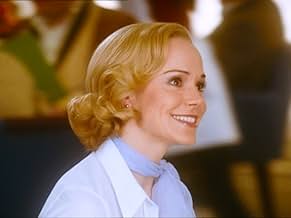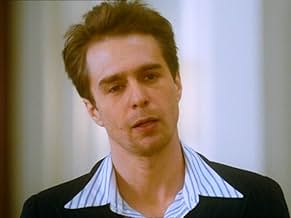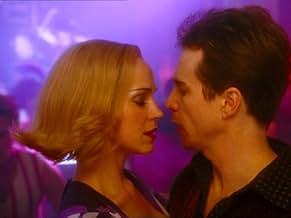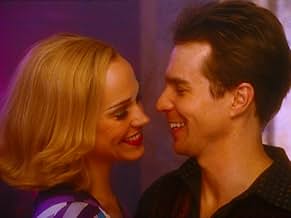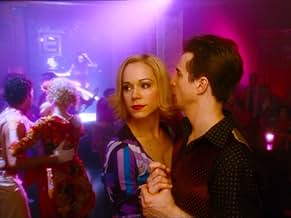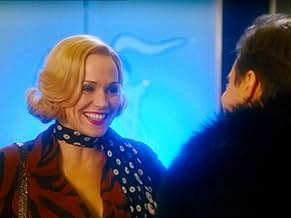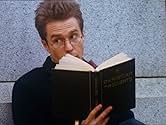AVALIAÇÃO DA IMDb
5,8/10
1,3 mil
SUA AVALIAÇÃO
Adicionar um enredo no seu idiomaSet in the 1930s, an American with a scandalous reputation on both sides of the Atlantic must do an about-face in order to win back the woman of his dreams.Set in the 1930s, an American with a scandalous reputation on both sides of the Atlantic must do an about-face in order to win back the woman of his dreams.Set in the 1930s, an American with a scandalous reputation on both sides of the Atlantic must do an about-face in order to win back the woman of his dreams.
- Direção
- Roteiristas
- Artistas
- Direção
- Roteiristas
- Elenco e equipe completos
- Produção, bilheteria e muito mais no IMDbPro
Avaliações em destaque
The mix of contemporary references and modern scenery, in what was ostensibly a period piece, just makes this film annoying. On top of this, the movie proves that Frances O'Connor cannot act, and that surrounding her with good actors and actresses will only increase the pain she causes audiences. Sadly, I really wanted to like this movie, but could not do so -- I love P.G. Woodehouse's work, and it is all eminently adaptable to film. Yet, somehow, the makers if this fiasco failed in what should have been a simple and enjoyable endeavor. This could either have been a period piece, or a modern adaptation, yet it is neither -- instead it is a mish-mash of references best suited for some sort of high school dramatic review. Do not pay money to see this!
I really had fun watching this movie. More like a play put in a film 9few location, great dialogs, situation and imbroglio comedy) but wait what a beautiful set design, the cast is great, the plot is vaudeville's but hey what do you aspect of a movie called: Picadily Jim! You will laugh, maybe not all the time, but the movie is construct on a good tempo and should entertain you. I really like those independent movies, not trying to create a new world but just trying to give us good time without taking us for granted.
Enjoy for what it is: a great moment of laugh, smiles and intelligence.
Thank you for the film
Enjoy for what it is: a great moment of laugh, smiles and intelligence.
Thank you for the film
Following scriptwriter Julian Fellowes's Academy Award for Gosford Park (2001), and its commercial success with a recreation of 1930s Britain, he was able to initiate the third film version of Piccadilly Jim. In itself, this was no small achievement, for the last P.G. Wodehouse movie on the English big screen had been The Girl on the Boat forty years before.
The Piccadilly Jim that finally emerged from Fellowes's screenplay was an interpretation deeply at odds with Wodehouse humor, the result of the selection of a director, John McKay, who was mismatched with the story. Unlike Robert Altman's direction of Gosford Park, McKay found the concept of a period setting distracting and labored to undercut it in every way. McKay sought to avoid the world of Wodehouse television adaptations and their country-house weekends. In its stead, McKay asserts an equivalence between the 1930s, the 1960s, and the world of 2004, as all one and the same.
McKay noted, "I think P.G. Wodehouse inhabits a parallel universe to the period he is writing about, so we should find a parallel universe to suit this Piccadilly Jim. We thus decided we would make up our own 'thirties'...." Every bit of decor looks less like the ostensible 1930s setting than one of the decade's science fiction visions of the world as it would shortly become. The designs attempt to evoke the satires of the sterile stylization of modernism in films by Jacques Tati or Stanley Kubrick. However, McKay has no real vision of his own; instead Piccadilly Jim is chock-a-block modern with anachronisms and absurd inventions. McKay's defiantly iconoclastic visuals are incongruous, their lack of internal coherence constantly preventing viewers from immersing themselves in the world of the story. Equally at odds with any narrative unity is the singing of modern songs and the presence of 21st century retro automobiles.
Costumes and make up are particularly outlandish, especially unbelievable coiffures that spike, thrust, or droop to one side. The romantic leads vary scene by scene from Jim in an enormous fur coat and scarf, to Ann in modern boots, to Jim and Ann in contemporary nightclub dress with resonances to 1970s disco.
In attempting to modernize Wodehouse, McKay lacks any conception of what has made the author successful. The opening sequence provides a sharp comparison of the divergent approach between the film versions of Piccadilly Jim in 1936 and 2004. In the former, Bayliss wakens Jim from a late night to discover he is asleep with his feet on the pillow where his head ought to be. Such a tasteful indicator of insouciance from the 1930s is beyond the sensibility of 2004; in this version Bayliss finds Jim in bed with three scantily clad floozies. Nothing could have been farther from the harmless spirit of Wodehouse, even when he portrays marital mores and infidelity in such theatrical adaptations as Candle-Light.
The Piccadilly Jim of 2004 is a true wastrel, a womanizer, brawler, and drunkard who is deeply unsympathetic. Robert Montgomery, the Piccadilly Jim of 1936, might have played such a character in a likable manner, but instead of the classical Hollywood stars who could so perfectly embody Wodehouse characters, 2004 offers the modern Sam Rockwell. His performance lacks charm or charisma; he plays the role as standard issue "bad boy." Of course, according to contemporary romantic formula, this must be the secret wish of Ann, whose characterization is altered substantially. Instead of Nesta writing thrillers, as in the novel, it is Ann who composes them, incorporating criminal brutality that reflects her own volatile, slightly disturbed nature. Jim compares her speech to that of Sam Spade, and her devotion to murder is portrayed as the direct result of Jim's scathing review of the book of her poetry. Yet her first impression upon meeting Jim (she does not know his true identity until the end) is that he is too much of a "Mr. Nice Guy," lacking the dangerous edge for which she yearns. Frances O'Connor plays much of the role in varying tones of hysteria, and frequent, rather obvious dubbing reveal an actress having understandable difficulty with her role.
The greatest error is in eliminating the sincerity of the remorse Jim must feel. In the novel, love changes him, and only later does Jim realize why Ann hates the man she never met: he penned a vicious review of her book of poetry. This theme was retained, according to surviving plot synopses, in the original, now-lost faithful 1919 movie of Piccadilly Jim, with Owen Moore in the title role. The 1936 film of Piccadilly Jim had Jim pen cartoon parodies of the Pett family in retribution for their condescending treatment of his father, before Jim knew Ann was their relative. The 2004 version makes an alteration that ruins the credibility of Jim's transformation. The columns under the byline "Piccadilly Jim" were penned by a ghost writer, meaning that Jim never did actually wrong Ann. To compensate, he need do no more than punch the real writer in the nose. Without the need for contrition, Rockwell etches a Jim incapable of remorse, rendering the central conflict meaningless. All that remains is a playboy who has found an equally wild girl.
If a 21st century movie adaptation of Wodehouse requires actors like Rockwell who need to be introduced in bed with three women, there is indeed little place for Wodehouse in theatrical feature films. 1930s behavior is not the same as the present, and having Ann arrange for assignations with Jim, or making him give a goodbye kiss to Bayliss, masquerading as his father, only seem crass. Perhaps it is best for Wodehouse to remain on television, where he need only appeal to narrower, more literary audiences, comfortable with the flavor of another, more distant era.
The Piccadilly Jim that finally emerged from Fellowes's screenplay was an interpretation deeply at odds with Wodehouse humor, the result of the selection of a director, John McKay, who was mismatched with the story. Unlike Robert Altman's direction of Gosford Park, McKay found the concept of a period setting distracting and labored to undercut it in every way. McKay sought to avoid the world of Wodehouse television adaptations and their country-house weekends. In its stead, McKay asserts an equivalence between the 1930s, the 1960s, and the world of 2004, as all one and the same.
McKay noted, "I think P.G. Wodehouse inhabits a parallel universe to the period he is writing about, so we should find a parallel universe to suit this Piccadilly Jim. We thus decided we would make up our own 'thirties'...." Every bit of decor looks less like the ostensible 1930s setting than one of the decade's science fiction visions of the world as it would shortly become. The designs attempt to evoke the satires of the sterile stylization of modernism in films by Jacques Tati or Stanley Kubrick. However, McKay has no real vision of his own; instead Piccadilly Jim is chock-a-block modern with anachronisms and absurd inventions. McKay's defiantly iconoclastic visuals are incongruous, their lack of internal coherence constantly preventing viewers from immersing themselves in the world of the story. Equally at odds with any narrative unity is the singing of modern songs and the presence of 21st century retro automobiles.
Costumes and make up are particularly outlandish, especially unbelievable coiffures that spike, thrust, or droop to one side. The romantic leads vary scene by scene from Jim in an enormous fur coat and scarf, to Ann in modern boots, to Jim and Ann in contemporary nightclub dress with resonances to 1970s disco.
In attempting to modernize Wodehouse, McKay lacks any conception of what has made the author successful. The opening sequence provides a sharp comparison of the divergent approach between the film versions of Piccadilly Jim in 1936 and 2004. In the former, Bayliss wakens Jim from a late night to discover he is asleep with his feet on the pillow where his head ought to be. Such a tasteful indicator of insouciance from the 1930s is beyond the sensibility of 2004; in this version Bayliss finds Jim in bed with three scantily clad floozies. Nothing could have been farther from the harmless spirit of Wodehouse, even when he portrays marital mores and infidelity in such theatrical adaptations as Candle-Light.
The Piccadilly Jim of 2004 is a true wastrel, a womanizer, brawler, and drunkard who is deeply unsympathetic. Robert Montgomery, the Piccadilly Jim of 1936, might have played such a character in a likable manner, but instead of the classical Hollywood stars who could so perfectly embody Wodehouse characters, 2004 offers the modern Sam Rockwell. His performance lacks charm or charisma; he plays the role as standard issue "bad boy." Of course, according to contemporary romantic formula, this must be the secret wish of Ann, whose characterization is altered substantially. Instead of Nesta writing thrillers, as in the novel, it is Ann who composes them, incorporating criminal brutality that reflects her own volatile, slightly disturbed nature. Jim compares her speech to that of Sam Spade, and her devotion to murder is portrayed as the direct result of Jim's scathing review of the book of her poetry. Yet her first impression upon meeting Jim (she does not know his true identity until the end) is that he is too much of a "Mr. Nice Guy," lacking the dangerous edge for which she yearns. Frances O'Connor plays much of the role in varying tones of hysteria, and frequent, rather obvious dubbing reveal an actress having understandable difficulty with her role.
The greatest error is in eliminating the sincerity of the remorse Jim must feel. In the novel, love changes him, and only later does Jim realize why Ann hates the man she never met: he penned a vicious review of her book of poetry. This theme was retained, according to surviving plot synopses, in the original, now-lost faithful 1919 movie of Piccadilly Jim, with Owen Moore in the title role. The 1936 film of Piccadilly Jim had Jim pen cartoon parodies of the Pett family in retribution for their condescending treatment of his father, before Jim knew Ann was their relative. The 2004 version makes an alteration that ruins the credibility of Jim's transformation. The columns under the byline "Piccadilly Jim" were penned by a ghost writer, meaning that Jim never did actually wrong Ann. To compensate, he need do no more than punch the real writer in the nose. Without the need for contrition, Rockwell etches a Jim incapable of remorse, rendering the central conflict meaningless. All that remains is a playboy who has found an equally wild girl.
If a 21st century movie adaptation of Wodehouse requires actors like Rockwell who need to be introduced in bed with three women, there is indeed little place for Wodehouse in theatrical feature films. 1930s behavior is not the same as the present, and having Ann arrange for assignations with Jim, or making him give a goodbye kiss to Bayliss, masquerading as his father, only seem crass. Perhaps it is best for Wodehouse to remain on television, where he need only appeal to narrower, more literary audiences, comfortable with the flavor of another, more distant era.
I really wanted to enjoy this film as I am a fan of many of the actors involved. Unfortunately, the story didn't work for me. I have given this 7 stars because of the actors.
Actors tend to place their trust in directors, even old stalwarts such as Mr Palmer, Ms Blethyn and Mr Wilkinson. Once the point has been missed by the producers/director, although in this case I don't think the point was ever sighted, the production must run its collision course with disaster, and not even such fine actors as were employed to give it life, could save Piccadilly Jim .
PG Wodehouse was a successful writer who knew the value of the suspension of disbelief, and was able to deliver the theatrical creation of a world which, although highly unlikely, with a cleverly constructed set of plausibilities, would, and did, pass as the truth.
Theatre has many natural enemies. Because it is not the truth, but the appearance of truth, theatre has many tricks and falsehoods in its infrastructure, and these are all susceptible to betrayal in drama, but in comedy they are especially vulnerable. The absolute death sentence on comedy, is to "mug" (pull faces) to attempt to be funny, or to overstate a quirk or characteristic.
In Piccadilly Jim, the director breaks all the rules of good comedy by allowing, not only "mugging," and (keep it in) play funny work, but a whole swatch of clashes to occur. Modern dress, modern language, caricature rather than character, a mysterious failure at irregular intervals to use film language, and the erratic use of tempo, which often stifles its own dialogue.
Many a great opera singer has come unstuck via the technicalities of a so called simple folk song. Perhaps this film came likewise unstuck, by its creators missing the hidden vortex within the supposed simplicity of the original story.
PG Wodehouse was a successful writer who knew the value of the suspension of disbelief, and was able to deliver the theatrical creation of a world which, although highly unlikely, with a cleverly constructed set of plausibilities, would, and did, pass as the truth.
Theatre has many natural enemies. Because it is not the truth, but the appearance of truth, theatre has many tricks and falsehoods in its infrastructure, and these are all susceptible to betrayal in drama, but in comedy they are especially vulnerable. The absolute death sentence on comedy, is to "mug" (pull faces) to attempt to be funny, or to overstate a quirk or characteristic.
In Piccadilly Jim, the director breaks all the rules of good comedy by allowing, not only "mugging," and (keep it in) play funny work, but a whole swatch of clashes to occur. Modern dress, modern language, caricature rather than character, a mysterious failure at irregular intervals to use film language, and the erratic use of tempo, which often stifles its own dialogue.
Many a great opera singer has come unstuck via the technicalities of a so called simple folk song. Perhaps this film came likewise unstuck, by its creators missing the hidden vortex within the supposed simplicity of the original story.
Você sabia?
- CuriosidadesFirst film appearance of Sia. She appears briefly as a singer in a bar and, unusually, her entire face is clearly visible!
- Citações
Ann Chester: It's too bad you don't have any bad habits. We could have had ourselves a good time on that old boat.
- ConexõesVersion of Piccadilly Jim (1919)
Principais escolhas
Faça login para avaliar e ver a lista de recomendações personalizadas
- How long is Piccadilly Jim?Fornecido pela Alexa
Detalhes
- Data de lançamento
- Países de origem
- Idioma
- Também conhecido como
- Piccadilly Jim
- Locações de filme
- Empresas de produção
- Consulte mais créditos da empresa na IMDbPro
Bilheteria
- Orçamento
- US$ 15.000.000 (estimativa)
- Tempo de duração1 hora 37 minutos
- Cor
- Mixagem de som
- Proporção
- 2.35 : 1
Contribua para esta página
Sugerir uma alteração ou adicionar conteúdo ausente

